An agile coach advised a project manager to continuously improve their ability to support their team and remove any obstacles in the project's way. What role is the agile coach advising to the project manager to take on?
During the project initiation stage, a team has estimated story points for all user stories. When the project team explained the minimum marketable feature (MMF), however, they were not confident that the solution would actually work.
What can the team do to better manage this situation?
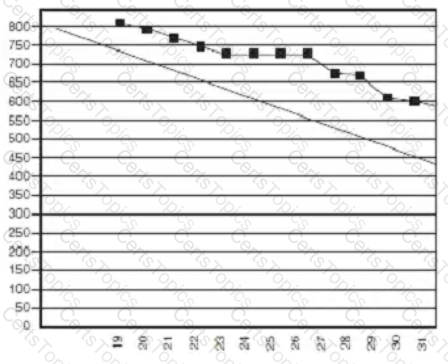
Based on the burndown chart, what is the iteration's status?
Following approval of a business case, a company will introduce a new mobile app for customers to place orders. Time to market is a key concern. The product has entered into the 3rd iteration, but the team is concerned because they feel the technical designs do not meet the agreed-on definition of done (DoD). An agile coach has been hired to help validate product delivery against business requirements.
What should the agile coach do?
An agile practitioner is working on a project to migrate data from computer systems to another location. To accomplish this task, they need to run four activities sequentially that different teams are performing. The teams are migrating two systems per day, but the agile practitioner thinks that three systems should be done per day.
What can be done to improve process efficiency?
Midway through a project the product owner learns from the sponsor that a major component, which is already 20 percent complete, is unimportant to users. The component was part of the approved scope and a key selling point for the project
What should the product owner do next?
Toward the end of a project the product owner discovers that the project has a high probability of failure due to a critical feature not functioning as expected What should the product owner do?
During its first sprint, a new scrum team realizes that it has insufficient team members with test automation skills to effectively complete its stories. What should the team do?
A new product owner shares the product vision during the team launch event. The team asks for clarification on the product roadmap and its high-level features.
What should the product owner do?
A scrum team is working together virtually. One of the team members sends a daily email to the other team members listing impediments that they find. During retrospective meetings, the team member complains that their colleagues fail to take actions on the impediments.
How should the team address this issue?
A company president is concerned about the impact of a natural disaster on the company. How should management identify areas to apply its resources and mitigate potential impacts?
An organization strives hard to accelerate value delivery by improving product design, development, and transition activities. What ways of working should the organization discontinue to become an effective player?
What is a specific development practice that has been effective in implementing disciplined DevOps?
The executive leadership wants to understand ways to better deliver on time and on budget. What can the project team do to assist in achieving the organizational goal?
A team is creating a highly marketed, time-sensitive product. The agile coach is concerned that anything other than exceptional quality will result in bad publicity for the company. What should the agile coach ensure that developers do?
During backlog refinement meeting, the new developer on the team asks the product owner to discuss a new performance threshold requirement and how it impacts the stories in the backlog. What should the team do?
A user interface (UI) developer has features for channels ready for review. During the team review, the architect is disappointed that Splunk software has not been implemented for better server and client logs. The architect insists on the implementation of Splunk software, which will impact the release date.
Which one of the following is the ideal option for the team to resolve this conflict?
An agile team is working on the first sprint, and have already planned the second and third sprints. However, market conditions now require a change to the features. What should the product owner do?
All blockers are caused by some Impediments, but not all impediments are blockers. Which two scenarios should be considered blockers? (Choose two.)
A development team has started working on a new service but is unsure if the service fits the customer's requirements. What should the product owner do to ensure that the service will benefit the customer?
The risk profile of a project has increased beyond the upper threshold of tolerance. The product owner and project leader meet to discuss an approach for dealing with this.
What should the team do next?
During an iteration, an agile team discovers infrastructure requirements that were not initially considered. What should the team do to effectively manage this?
A project team tasked with delivering a solution with extremely aggressive timelines is facing an issue with meeting their sprint velocity targets. To address this issue and bring the project back on track, what action should the team take?
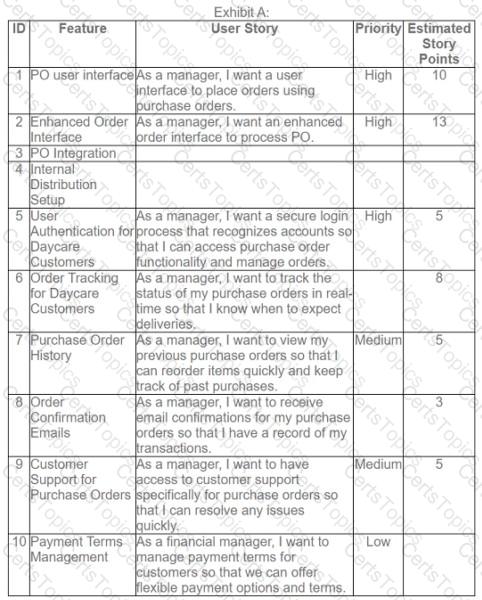
A food company seeks additional business-to-business (B2B) revenues from some customers by
implementing purchase order (PO) functionality. To achieve this, the agile project team is exploring PO integration options (see item #3 in Exhibit A), as the product increment (PI) planning process is underway.
What should the project team do next?
During a sprint demo, a business representative identifies missing requirements. The agile practitioner realizes that all key stakeholders were not included during requirements detailing.
What should the agile practitioner have done to avoid the situation?
During a review close to a product release, the customer spotted several features that will need to be changed. What caused this to happen?
A Kanban team is struggling to prioritize and determine which tasks to handle first according to value. What should the team do to improve this situation?
During the iteration planning of a newly onboarded agile team, the product owner adds a set of high priority user stories into the iteration backlog. What should the team do first to define the tasks needed to implement the user stories?
A scrum master of a team that is new to Scrum wants to share the purpose of the daily coordination meeting. What should the scrum master tell the team?
A team is transitioning from a predictive approach to an agile approach Historically, the team has delivered work products that did not meet customer expectations.
What agile practice can help the team to alleviate this?
The agile team has failed to meet their iteration goal, and contention has developed between members. The agile leader would like to determine how to improve the team's productivity and morale.
How should the agile leader address this?
A large, corporate organization is forced to hire new team members in a geographically remote location from the current team. The manager of the department is concerned about the team not being colocated.
What behavior would indicate the team is not working well together?
A member of the development team is working on a prioritized non-functional requirement involving integrating with a 3rd party system. This integration has not been done before on the project.
What should the project leader suggest?
A team is preparing to demonstrate new product capabilities to a leadership team. The demonstration will show working software and a listing of the projected value of the capabilities.
What should the team do to ensure the demonstration is successful?
The productivity of an agile team has fallen significantly in the last sprint. The team members have not mentioned any impediments but seem to be fatigued.
What should the agile practitioner do?
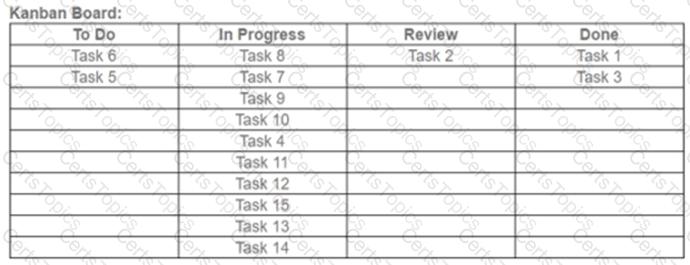
A product owner is working on a special agile project for the automobile industry. The project team is responsible for all of the issues related to vehicle electronic control units. The team hasobserved a significant backlog of items in the “In progress' column (Refer to the kanban board). This accumulation is causing delays in task completion and impacting overall project timelines. The team operates in a dynamic environment where requirements frequently change, and stakeholders demand quick turnarounds.
What should the project team adopt to address this issue and improve task flow, considering all the demands?
A scrum team is working on an important project with a short deadline. To save time and reduce overhead, the product owner proposes that the regular sprint reviews should be cancelled and replaced with a review of each release according to the release plan.
What should the scrum master do?
Members of an agile team are complaining that user stories are too large, taking multiple sprints to complete them. They say this way of working is becoming difficult to handle and it has been challenging to map relationships between stories. This situation is affecting the value delivery for the product owner.
What should the scrum master do to handle this situation?
How can the scrum master respond to a stakeholder who suggests using velocity as a metric to measure team efficiency in an agile project?
One of the main stakeholders of a project is new to Scrum. The stakeholder asks what to expect in the sprint retrospective.
How should the product owner respond?
One of the overseas stakeholders on an agile project has not been actively involved in the project's development. What would be the first step to reengage the stakeholder?
A development team, new to scrum, questions the need to collect metrics on team performance. While learn members understand velocity and burn down, they feel that once velocity becomes settled it is needless to keep track.
What should the agile coach tell the team?
Midway through a sprint, a team member discovers that the product design fails to adhere to the organization's enterprise architecture standards. Since this required escalation to the architecture team for further analysis and resolution, the team was unable to deliver its sprint goal and the sprint was cancelled.
What should the team have done to avoid this?
The product owner is present at the sprint review meeting and states that an estimation for the end of the project must be shared with the company’s steering committee. The scrum master declares that the team reached an average velocity of 40 story points per sprint, considering a biweekly iteration. The team members predict that there are 240 story points remaining.
What is the estimated project conclusion?
Midway through a sprint, a scrum team member advises the team of a new requirement that may change the initial scope. What should the team do?
A new CIO advocates an agile framework for new IT projects, but the team has reservations. How should the CIO ensure that the team will be aligned with this?
After conducting the second retrospective with project stakeholders, the customer expresses frustration. The customer wants a more predictable roadmap for the delivery of features and functionalities.
How should the project manager respond to the customer?
An agile team identifies that their velocity is lower than predicted, and that their previous forecasts in the product roadmap are wrong. The team is worried that they will be unable to meet a critical release date without corrective action.
What should the team do?
The lead developer informed the team that they have learned of some possible integration challenges in creating customer dashboards using the architecture the team has chosen. What should an agile practitioner do?
An agile team's client has been asked to expedite the delivery of the next release. By delivering one month early, the company can generate USS40.000 more than expected for the quarter. What should the agile team do?
Several team members have complained to senior management about their scrum master's processes. What should the scrum master do to address the team's process concerns?
How can an agile team working on a new product ensure alignment with external stakeholders?
For what is the MoSCoW method used?
A team member starts discussing a project roadblock during a daily coordination meeting. The team discusses details of the impediment, which takes up most of the meeting time.
What should the agile facilitator do?
An agile leader notices that a team member is becoming very quiet and disengaged in meetings. What should the agile leader do to identify team members' personalities and motivators?
A member of a project's development team approaches the team lead and requests database administrator training. The team member believes that their inability to handle this work, and to rely on outside specialists, is impacting team velocity.
What should the agile team lead do?
An agile project manager observes that the Scrum team is falling behind on the completion of a particular sprint. What should the agile project manager do?
During the fourth sprint retrospective for an IT project, the team members develop a series of actions to improve problem solving in the next sprint. However, many team members are concerned that these actions will not be implemented, since there was no follow-up from the last retrospective meeting.
What should the scrum master do to improve team commitment to the recommendations from the retrospective meeting?
A client needs to release their product to market earlier than planned. They need to start receiving the expected revenue, according to their financial forecast, which will require completing the work left on all user stories in the backlog.
What should the project lead do to accommodate this request?
During a retrospective, team members suggest process improvement ideas. The agile team lead knows that, while many of these ideas are different from standard practices, a few of them are good. What should the agile team lead do?
When working with Lean approaches, which process includes the sequence of steps for delivering value and those required to carry them out?
A Scrum team decided to switch to Kanban for the maintenance phase of the product. The kanban board consists of the following columns "To do," "In progress," "Ready to be tested," "Test in progress," and "Done." Since the team changed their way of working, they have noticed the work is flowing slower in the system. A large queue of "Ready to be tested" work items has been building up.
What should the team do to improve its speed of delivery?
A Scrum team decided to switch to Kanban for the maintenance phase of the product. The kanban board consists of the following columns "To do," "In progress," "Ready to be tested," "Test in progress," and "Done." Since the team changed their way of working, they have noticed the work is flowing slower in the system. A large queue of "Ready to be tested" work items has been building up.
What should the team do to improve its speed of delivery?
During the high-level estimation for a project, the team contacted the product owner about the client’s requirements. The team is seeking guidance as their estimate is too big and there is a risk of not finishing the project in time.
What should the product owner do to help the team?
An agile team has been given a complex project with a basic set of requirements which need further elaboration and review. How should the team iteratively build out the backlog of requirements with the stakeholders?
A new stakeholder has recently joined a project. During a meeting with the scrum master, the new stakeholder tries to understand the status of the project and the remaining tasks for completion.
How should the scrum master inform the new stakeholder?
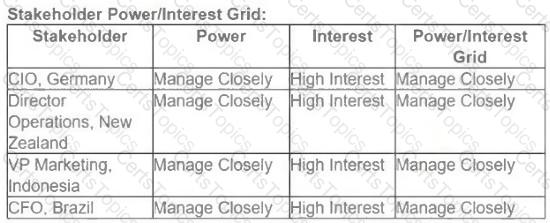
An agile development team is working on a digital transformation project and is facing challenges in obtaining consistent feedback from stakeholders who are dispersed around the world. The product owner is under pressure as this lack of engagement has led to prolonged decision-making cycles and has adversely affected the outcomes of sprints.
How should the team improve stakeholder engagement to help ensure timely feedback and better decision-making? (Refer to Stakeholder Power/Interest Grid)
DRAG DROP
All the developers on a project team are working offshore in a different time zone, resulting in many issues. Match the issues to the agile practitioner's recommendations for resolutions below. (Drag the Problems/Issues on the left to the box in the center, corresponding to the correct Recommendations for Resolution on the right)
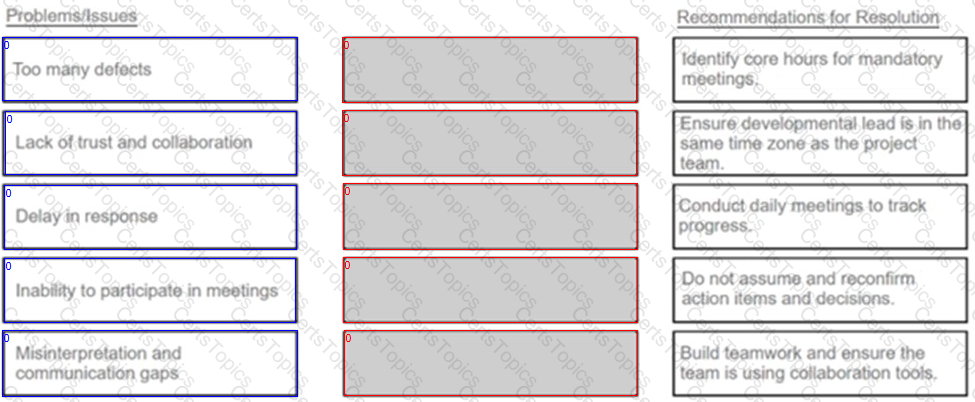
A project manager was assigned to lead the development of a new application for a company. The application will be widely used by all company employees around the world. During the firstmeeting with key project stakeholders, the project manager was asked to find a way to determinate all possible types of users who may interact with the application that is going to be developed.
What should the project manager do next?
An agile project team has team members with varying technical skills. Due to recent events that adversely impacted customer satisfaction, management mandated that Kaizen should be given more focus to ensure the quality in product delivery.
Kaizen is a prime concept of which agile practices?
An agile team notices that the same problems continue to occur during multiple iterations Several team members have suggestions to fix the problem.
What is the proper agile approach to handle this?
A new product owner needs to manage the backlog of a high-visibility fast-moving project that is consuming a considerable amount of time What should the product owner do?
A large project team is assigned to a complex technical project with many interdependent epics. The team starts to experience problems in the second sprint as the technical leads are independently unable to determine the needed solutions.
What should the project lead do to help the team?
A Scrum team has worked hard to reach their sprint goal, but impediments have prevented them from succeeding. The team needed help from a specialist on another team, but the specialist was on a 2-week vacation.
What should the scrum master do?
An agile team provides feedback that user stories include insufficient details to understand the requirements. What should the agile practitioner do?
A product that recently went to market is receiving a great deal of attention from upper management who expresses interest by directly emailing and calling the developer team. The team expresses frustration during a standup.
What should the Scrum Master do?
During project inception, an agile practitioner engages the stakeholder to ensure alignment on the project's strategy and vision. The stakeholder asks for detailed requirements, design and delivery plans.
What should the agile practitioner do?
An agile team discovers a new risk and identifies that its impact may be severe. What should an agile practitioner recommend?
An agile team is building a training safety video based on current government regulations. The agile coach knows the regulations are likely to change before the release date.
How should the agile coach address this change?
An agile project manager is planning the initial scope, schedule and cost range estimates on a new project. The team will be using Kanban to control work.
What metrics should the team use to measure performance?
Team A is working on the second sprint of a product release Team B which is an interdependent team located on the same floor, requires extensive and frequent information to complete its sprint goal.
What should the agile team lead do?
While attending a conference, an agile practitioner learns of a new user interface (Ul) framework that could benefit the team. What should the agile practitioner do next?
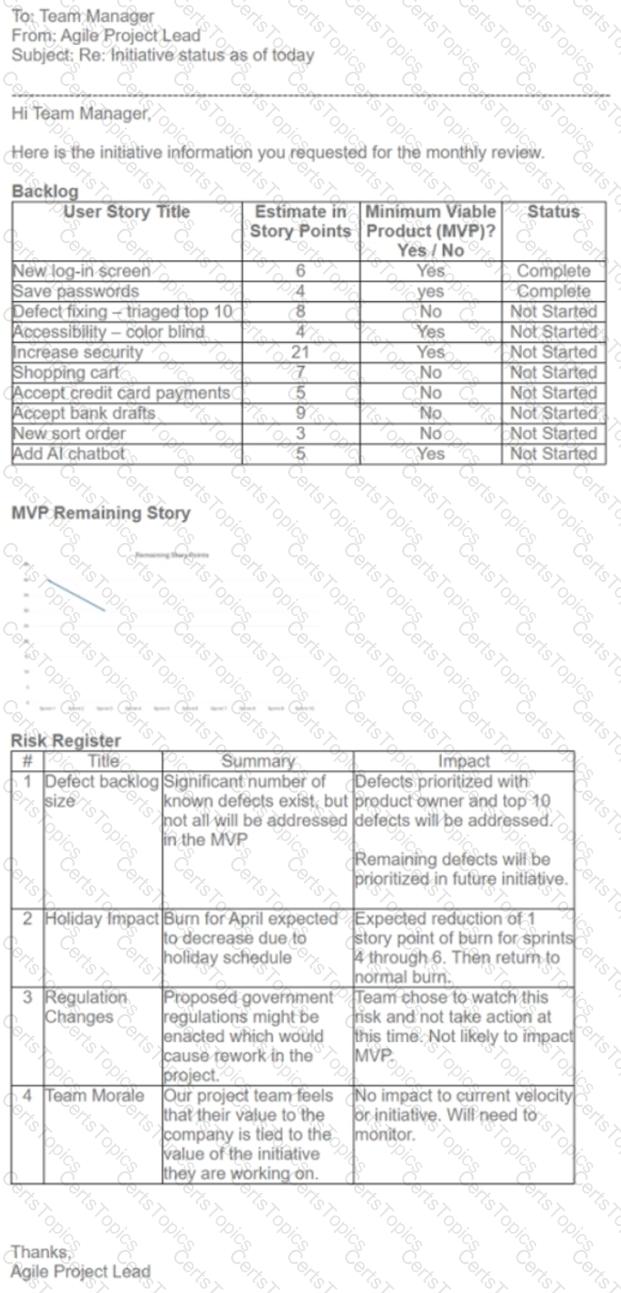
A project team's manager is responsible for delivering a specific initiative for the organization. They are preparing for a monthly meeting where the manager will present on the current state of this initiative. The agile project lead sends the manager the following email with the current initiative status (see Exhibit A).
At the end of which sprint will the minimum viable product (MVP) be completed?
A project manager is managing a large complex project with cross-functional teams using an adaptive approach. Frequent communication among the team leads of these cross-functional teams is crucial for the project to stay on track and deliver value according to the project plan.
Which agile communication practice should the project manager implement to ensure the cross-functional teams interact frequently?
A project team's standups often run over the allotted time as members attempt to resolve issues. With a large team, this is leading to productivity impacts and bringing complaints from some members that the meetings are wasting their time when they are not directly involved in an issue’s resolution.
How can the project leader help to manage the team's time?
An agile team is struggling with an issue. A team member mentions that another team had a similar issue that was resolved, but lessons learned documents are unavailable.
What should the agile practitioner do?
While struggling to take ownership of delivery an agile team fails to keep up with its sprint commitments What should the agile coach do?
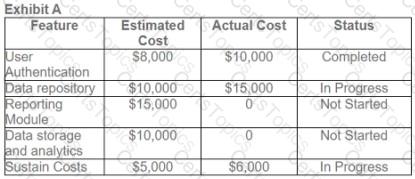
The product owner is working on an application that will be built in a data lake leveraging a data
integration and transformation software application. With a budget of US$17,000 remaining, how should the product owner allocate the money? (Refer to Exhibit A)
An agile team is planning the next iteration for a product release that has accumulated technical debt What should the team do?
A key stakeholder cannot attend the project vision statement development workshop. The stakeholder has emailed their requirements to the agile team lead, and believes that the vision statement is not critical.
How should the agile team lead respond?
An agile learn has been in place (or five years and the customer is satisfied with the team's performance and deliverables. Now that the product is buill and delivered, the customer is considering the future role of the Scrum Master.
What should the customer do?
After some iterations, the agile practitioner observes that the team is self-organizing in small knowledge silos. Which action should be taken regarding the team's behavior?
An agile team is in their 2nd iteration planning session. During the session, they are debating on whether regression and integration testing should be part of every iteration or part of the hardening iteration.
What should the agile lead recommend?
A new agile project leader habitually becomes involved in the work from a support perspective and uses information radiators to ensure that all actions to remove impediments are visible to the team. What is the agile project leader doing?
At the end of a product development phase, an agile project team confirms that all tests have passed. The product is released, but the customer complains that it is deficient. What should the project team have done prior to product release?
During mid-sprint changes, an agile facilitator meets with the executive and development teams. During the meeting, executive team members resolve conflicts, and on their own initiative, review the iteration charts to discuss changes to the iteration's functional goal.
What practice is the agile facilitator implementing?
Two agile teams from different company sites need to work and collaborate on the same project. What is the first action the agile project manager should take in order to ensure a smooth collaboration between the two teams?
During an iteration planning meeting, the team suggests changes to add product value that will require extra work and impact the schedule. What should the agile project leader do?
During a Kanban team's daily stand up, an agile coach observes that the team seems disinterested in the work status. While it appears that there are no issues with flow, there is a marked lack of attention to team effort. When the agile coach queries the team for reasons, members explain that work continues to be scheduled with no end in sight.
What should the agile coach do?
As user stories are developed, what should be done to record and update acceptance criteria?
An agile team is working on a new product. To ensure that all unknown issues are clarified before committing to the scope the team plans to work only on spike user stories for the next three sprints
What should the agile coach do in this situation?
An agile team and a traditional development team are working together on a project. Each team exceeds expectations regarding deliverables: however, issues arise when the deliverables are integrated. What should the agile practitioner do?
An agile coach realizes that a team responsible for a major release is a few months behind schedule. The marketing department is unaware of this delay and is planning to start the marketing campaign and announce the release.
What should the agile coach do?
An infrastructure team had to revamp so downstream channels could consume data from the data lake, thereby improving operational efficiency for the end customers. Which primary components should the product manager consider while plotting performance and dependencies on the product roadmap?
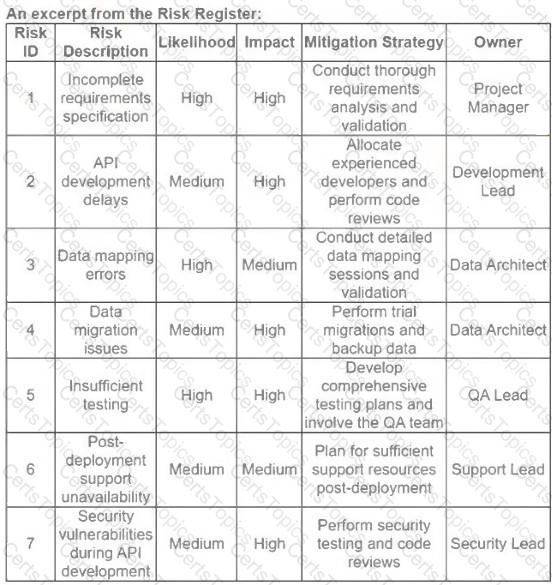
An e-commerce company acquired a tool to customize subject line generation for marketing campaigns. In sprint planning, the team discussed integrating this tool with the customer relationship management system.
Which mitigation strategy is most appropriate to ensure the final product meets the business objectives? (Refer to the Risk Register Exhibit)
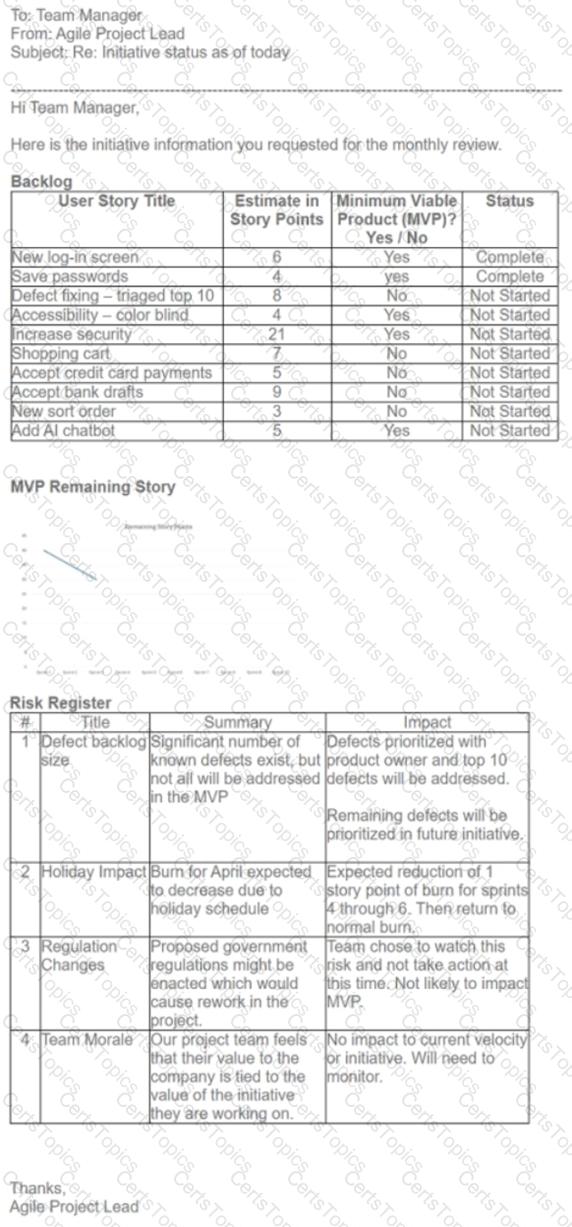
A project team's manager is responsible for delivering a specific initiative for the organization. They are preparing for a monthly meeting where the manager will present on the current state of this initiative. The agile project lead sends the manager the following email with the current initiative status (see Exhibit A).
How many sprints will be needed to complete the entire backlog?
During backlog refinement, the team uses an online planning poker tool for estimation. The junior developers change their number of story points after they see the estimations provided by the developers. The junior developers state that the reason for this is that they do not have enough experience and do not want to be blamed for sizing it wrong.
What should the scrum master do?
During a mature agile team's planning meeting, a team member proposes a new framework that would considerably reduce implementation time. However, the team lacks the confidence to try the new framework.
To help the team gain confidence, what should the agile practitioner suggest?
Iterations last between a couple of weeks to a couple of months, with a preference for the shorter time. What is the goal for each iteration?
A new project has been approved and is critical for an organization. The project sponsor has a limited budget, and the deadline to have all requirements meet the definition of done (DoD) is short.
Which approach should the agile practitioner take to facilitate the project's success?
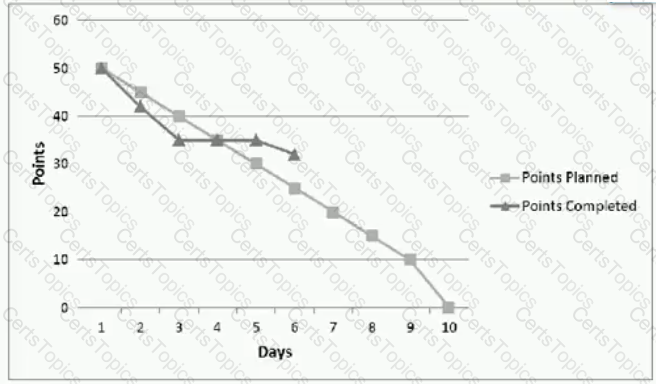
Based on the chart, what is the current status of the iteration when comparing story points planned versus completed?
A new project is under way and the team is using the Kanban method. One of the team members raised a specific issue related to a programming language that the team member faced in previous projects.
What should the project leader do to handle the issue?
The product owner wants to build security firewalls into the product. How can the team members support this?
A key stakeholder feels they do not understand the project at a comprehensive level. What should the agile practitioner do?
An agile team consisting of eight members is in their 11th iteration of a project. In the last iteration, the team was not able to complete every scope item it had committed to before the demonstration.
Which approach should the agile lead take?
An agile team consisting of eight members is in their 11th iteration of a project. In the last iteration, the team was not able to complete every scope item it had committed to before the demonstration.
Which approach should the agile lead take?
An agile team has started to worry because lately they have seen an increase in the number of issues. There seems to be a large variance in the quality of the work items delivered. The team now realizes that a shared understanding of quality may not exist among team members.
What should the team do?
During a review session, an agile team presented done requirements to a group of stakeholders Stakeholder feedback indicated that the done requirements failed to meet the most pressing needs and provide value.
What should the team have done to prevent this?
What should the agile practitioner know about tracking velocity?
A seven-member agile team's composition vanes considerably in age. gender culture, personality type, and professional background When planning a team-building event, what type of interpersonal skills should the project leader use?
An agile practitioner notices that team members are disengaged. As a result, the team's velocity has decreased. What should the agile practitioner do to get the team back on track?

Based on the backlog metrics in the chart what can explain the jump in points at the end of iteration 4?
An executive sponsor asks a team when a specific feature will be ready for release. A team member states the feature will be ready by the end of release 3 because it is not a core feature. The team member directs the sponsor to an information radiator, where the sponsor sees several notes grouped by release numbers and posted on the wall.
What is the sponsor looking at?
During planning sessions an agile practitioner notices that some team members do not share common ideas What should the agile practitioner do?
An organization wants to execute a corporate website redesign project using Scrum. There is an experienced pool of agile team members from a previous project, as well as a pool of available internal team members with some Scrum background.
What should be considered when selecting the team?
An agile project leader notices that the team's velocity has decreased in examining data provided by team members, the project leader discovers that one team member has been slow to enter story statuses
What can happen as a result?
During backlog refinement, a team routinely creates tests to demonstrate to the customer that each acceptance criterion has been met. Most acceptance tests results are observable or demonstrable, but testing for one requirement is providing a challenge to the team. The requirement states that the home button should be recognizable and the team is unsure how to test this.
What should the team lead do?
A customer and a product delivery team meet to discuss a product's attributes, goals expectations. hypothesis1 and high-level needs. What is a benefit of this meeting?
An executive sponsor of a new scrum team actively attends scrum ceremonies How does this benefit the team?
A newly formed scrum team wants to foster an environment of transparency and experimentation. The team decides to use a Kanban board to record and track encountered impediments Emphasis is placed on how issues are resolved and the strategies for preventing them in the future Over time what will be the result of this approach?
During a project review, the team discovers customer feedback that would add scope. The project leader is concerned that the team will be unable to incorporate this feedback and still meet the product launch date.
What should the project leader do?
A project was delivered in a foreign country for a big customer, but there are a lot of complaints about the way the functionality was implemented. Now there is a new project to fix the defects of the first one.
What strategy should be used to deliver it successfully?
A project's first iteration contains item A and its second iteration contains item B The first iteration is behind schedule, which will impact the second iteration. Since items A and B are similar, a team member suggests beginning the design of item B.
What should the agile practitioner do?
On an agile project, some of the development team is struggling to understand how the tasks and user stones fit into the overall product. How should this be addressed?
How can a project team effectively work toward a common goal and communicate as they scale and expand to build a new business-critical platform, given that they have been responsible for a small customer-facing product with little complexity over the past 2 years?
A project team developer has been involved in a large corporate initiative that has negatively impacted team productivity on another project to which they have been assigned. How should the developer have handled this situation?
A scrum master has a team of six members. The team complains they are losing time because they are attending meetings for which they see no value.
What should the scrum master do?
An organization initiates a pilot project to introduce agile methodology for the successful delivery of projects. What should the project manager do to share this project's knowledge and learning with wider organizational business groups?
A newly formed, colocated team is participating in daily standups, but is otherwise working largely as individual contributors. This has resulted in misalignment of activities. Planned velocity is being met.
What should the agile practitioner do?
The team is derailed by a demand from a senior manager unrelated to the project. How does the agile coach help the team?
Senior management is frustrated at the lack of a detailed implementation plan that shows exactly when the project will end and when all requirements will be met. The team has been using a rolling wave planning approach so far on the project.
How should the agile practitioner explain to senior management the benefits of this approach?
During a backlog refinement meeting, a senior team member raises a concern about an epic sizing that requires the use of a new interface for a vendor product. The product owner acknowledges this as a risk. What should the product owner do now?
To create the project vision, an agile team has scheduled an initial meeting with their customer representative. What should the team bring to this meeting?
A customer has difficulty explaining how the highest priority feature will work. What should the agile project manager do?
Several potential risks have been identified for a new project that started last month. The project manager is worried that the team is not fully aware of these potential threats.
What should the project manager do?
Conversation transcript between the customer and the product owner (PO):
Customer: I am requesting a calendar feature for scheduling and reminding of upcoming releases that we can manage. We also need the calendar to indicate quarterly metrics deadlines, code freeze dates for financial close, and things like that.
PO: My understanding is that this is for tracking project deadlines. Would you need to see the project deadlines on your phone calendar?
Customer: Yes. I need to see a single snapshot on my phone. So, is it possible for me to connect my phone to this calendar app?
PO: Let me write up the requirements and get the development team on board with the deadlines. What phone do you own?
Customer: I own an Android phone, but I also need integration with the Apple phones.
Identify three minimum viable product (MVP) items. (Refer to Conversation transcript between the customer and the product owner (PO). Choose three.)